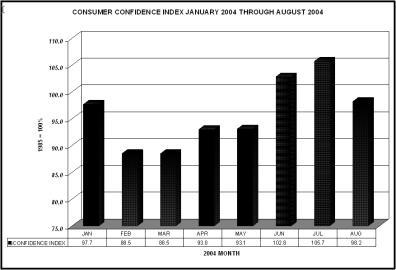Patricia Johnson: Consumer Confidence Index
Consumer Confidence Index
By Patricia L Johnson
Consumer confidence is considered an important economic indicator as consumer spending accounts for a major portion of U.S. economic activity. Consumer spending was running two-thirds, or 66% of GDP, but is now 70% of GDP. The level of consumer confidence can be directly related to consumer spending as the more confident consumers are about the economy; the more likely they are to spend.
Each month TNS NFO, headquartered in Greenwich CT, conducts the Consumer Confidence survey for The Conference Board. The survey is fielded from and results are processed at the TNS Northwood Ohio facility.
The survey originated in 1967 and was conducted on a bi-monthly basis through the middle of 1977, but from June 1977 forward the data has been collected monthly. Results are converted to an index and compared to the 1985 average of 100. During this 37-year period of time the five questions asked consumers have remained the same.
Samples are drawn from the TNS-NFO Access Panel of households and 5,000 surveys are sent by mail to individuals. The samples are balanced to be nationally representative according to U.S. Census figures, and are selected so that no household may receive the survey more than once over a 24-month period of time.
Approximately 3,500 completed surveys are returned to TNS-NFO each month and respondents are asked to appraise the following using a Positive, Negative or Neutral response.
1. Respondents’
appraisal of current business conditions.
2. Respondents’
expectations regarding business conditions six month
hence.
3. Respondents’ appraisal of the current
employment conditions.
4. Respondents’ expectations
regarding employment conditions six months hence.
5.
Respondents’ expectations regarding their total family
income six months hence.
The three indexes are then averaged and calculated as follows:
“The response proportions to each question are seasonally adjusted. For each of the five questions (above) the POSITIVE figure is divided by the sum of the POSITIVE and NEGATIVE to yield a proportion, which we call the ‘RELATIVE” value. For each question, the average RELATIVE for the calendar year 1985 is then used as a benchmark to yield the INDEX value for that question. The Indexes are then averaged together as follows: Consumer Confidence Index: Average of all 5 Indexes; Present Situation Index: Average of Indexes for questions 1 and 3; Expectations Index: Average of Indexes for questions 2, 4 and 5.”Source: The Conference Board
Seasonal adjustments are made by The Conference Board after receiving the data from NFO, and the indexes are released on the last Tuesday of each month at 10:00 a.m. EDT.
Consumer Survey responses received in
August 2004 compared to July 2004 indicate
Consumer
confidence has declined in all areas.
| CONSUMER SURVEY RESPONSES |
AUGUST 2004 |
JULY 2004 |
| Business Conditions "Good" |
23.2 | 25.2 |
| Business Conditions "Bad" | 20.1 | 19.1 |
| Jobs are "Plentiful" |
18.1 | 19.7 |
| Jobs are "Hard to Get" | 25.8 | 25.7 |
| Anticipating conditions to worsen | 8.8 |
7.1 |
| Expecting conditions to improve | 20.1 |
23.0 |
| Expecting fewer jobs | 15.4 | 13.5 |
| Anticipating more jobs | 16.2 |
19.5 |
| Expecting incomes to rise over next six months | 19.3 |
18.0 |
Source: August 2004 Consumer Confidence Index, The Conference Board
Preliminary results for the month of August, released August 31, 2004, indicate a major loss in all consumer confidence indexes as follows:
| INDEX NAME | AUGUST 2004 | JULY 2004 | DIFFERENCE |
| CONSUMER CONFIDENCE |
98.2 | 105.7 | -7.5 |
| EXPECTIONS | 105.3 | 96.6 |
-8.7 |
| PRESENT SITUATION |
106.4 | 100.7 | -5.7 |
Source: August 2004 Consumer Confidence Index, The Conference Board
Although the Confidence Index took a 7.5% decrease in August, more than likely due to the paltry 32,000 new jobs reported by the Department of Labor for July, the index remains higher than the lows seen earlier this year.

Click for big version
The highest point the Consumer Confidence Index ever reached was 144.7 in January of 2000 under the Clinton administration.
© 2004 Patricia Johnson
Patricia Johnson is a freelance writer
and CEO of Articles and Answers. Visit us online at www.ArticlesandAnswers.com


 Gordon Campbell: On Why The US Stands To Lose The Tariff Wars
Gordon Campbell: On Why The US Stands To Lose The Tariff Wars Eugene Doyle: Before It’s Too Late - Reimagine New Zealand’s Military Future
Eugene Doyle: Before It’s Too Late - Reimagine New Zealand’s Military Future  Binoy Kampmark: Gender Stunts In Space - Blue Origin’s Female Celebrity Envoys
Binoy Kampmark: Gender Stunts In Space - Blue Origin’s Female Celebrity Envoys Richard S. Ehrlich: A Deadly Earthquake & Chinese Construction
Richard S. Ehrlich: A Deadly Earthquake & Chinese Construction Ian Powell: It Does Matter To Patients Whether They Are Operated In A Public Or Private Hospital
Ian Powell: It Does Matter To Patients Whether They Are Operated In A Public Or Private Hospital Gordon Campbell: On Marketing The Military Threat Posed By China
Gordon Campbell: On Marketing The Military Threat Posed By China